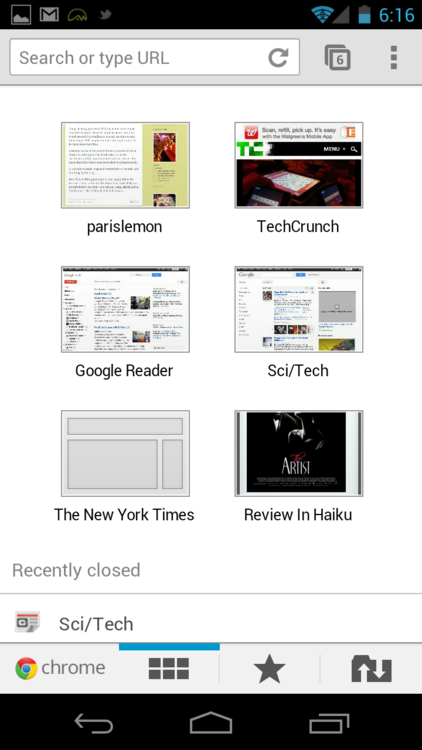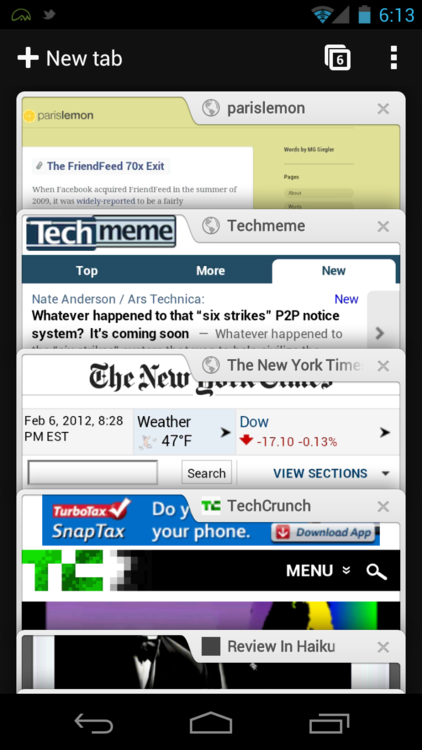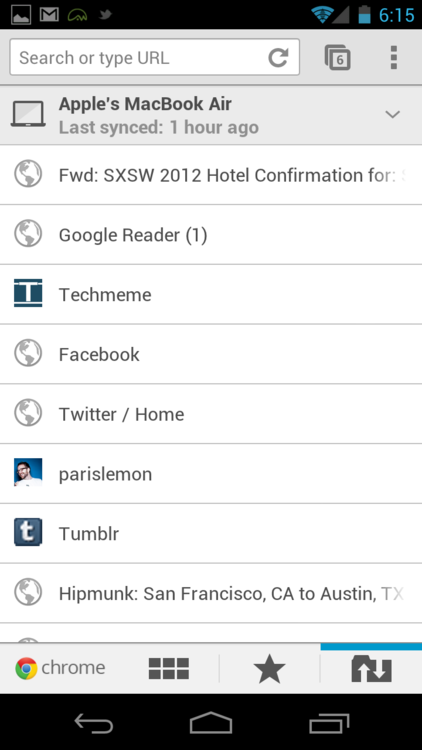Chrome For Android: The Browser For The 1%

My title is literal, figurative, and facetious all in one. I just hope Google has a good sense of humor about it — because they have a good product on their hands.
First of all, yes, Chrome for Android is here. Second, it’s only compatible with Ice Cream Sandwich which is currently on — wait for it — 1% of Android devices. But in an attempt to add some silver-lining to the 1% joke, I will say that Chrome for Android is of a much higher class than the previous Android browser, the aptly-named and horribly icon’d: Browser.
Browser is dead. Long live Chrome.
The Chrome/Android question is as old as the two products themselves. Both products were initally launched in September 2008 (though there was an Android beta before that). But even though Google made its own browser in Chrome. And Android shipped with its own browser — it was not Chrome. When asked why this was, Google had a wide variety of reasons throughout the years.
But when the question was asked during a Chrome panel at Google I/O last year, the response changed a bit. “It’s not something we’re talking about right now.” And: “I don’t know how to answer that.” The reason for the odd responses? Work had begun on Chrome for Android.
In fact, the browser is a year in the making Google SVP of Chrome Sundar Pichai says. But as I laid out last May, it wasn’t as easy and simply porting some code over to Android, it required a lot of thought to do it right.

The good news is that the end result is mostly right. The better news is that the product launching today is still in “beta”, so I’m sure it will get even more polish before it formally launches in a few months and becomes the default browser for Google’s flavor of Android.
Given my interest in the topic over the years, Google gave me an early look at the browser and I’ve been using it for the past few days. There are a number of things that are noticeably better than the browser I consider to gold standard of mobile web browsing: mobile Safari for iOS. And there are a few things it still does worse. But I have no doubt that like the original version of Chrome, Chrome for Android is going to push all browsers forward.
“Chrome is still all about speed,” Pichai says. But speed on a mobile device is different than speed on a desktop. The processor is weaker, for one thing. Click zones are much smaller on the smaller screens. And a concept like tabs has to be re-thought.
Chrome for Android is designed around the concept of “a stack of webpages in your hand”, I’m told. And the methaphor works well when you play with the software. Simply put: the Chrome team has done an excellent job turning the concept of multiple tabs into a beautiful and responsive interface for browsing on a phone.
Each website is a card (not unlike webOS cards) and you can flip through them side to side, or through a stacked overview interface. Flipping through side-by-side actually reminds me a lot of four-finger multi-touch app switching in iOS 5 on the iPad. The stacked tabs overview page is a brilliant way to manage dozens of tabs open at once (I’m told there is no limit to the number of tabs you can have open, but that something “interesting” happens if you go past 99).

Something else Chrome for Android brings: Incognito Mode. Yes, just like the PC version, you can now “safely” browse the web without worrying about cleaning up your trail later.
Also along for the ride: Google’s V8 JavaScript engine, GPU acceleration, web page pre-rendering, and yes, the Omnibox! These are all a big part of the Chrome team bringing what they call a “fully equipped browser” to the mobile experience.
Having said that, there is a notable absense in Chrome for Android: Flash. This probably shouldn’t be too surprising considering that Adobe themselves are talking about ending mobile support. But still, to the dismay of many of us, Google has insisted on baking Flash into Chrome for years now.
But the real killer feature of Chrome is sync. Because the newer versions of the browser for PCs allow you to sign in with your Google account, it can remember not only passwords and bookmarks, but open tabs as well. And those open tabs transfer to the mobile version via the “Other devices” area.
Say I have 5 tabs open in Chrome on my iMac and I get up to leave my home. I can see all 5 in Chrome for Android. And if I have 3 other tabs open on my MacBook Air, I can see those as well, all labeled and separated.

If you close Chrome, you’ll lose these (since no tabs would be open any more), but if you just do something like close your MacBook lid, you’ll still be able to see them. And the craziest part is that you can load one and hit the back button and go to the page that took you to your current page no matter where you were doing the browsing. Sync handles it all.
Back to the bad news: some of the more advanced features of Chrome for Android require APIs found only in Ice Cream Sandwich, so the team made the call to make it only available for Android 4.0 and beyond. Again, this means only 1% of current Android users out there can actually get and use the browser right now.
One would hope that the 1% number will rise quickly, but as we’re all well aware, that’s mainly in the carriers/OEMs hands now.
But Chrome for Android will work on Ice Cream Sandwich tablets as well — and the UI is slightly different to accomodate the larger screens. One example: you can see mutliple tabs in a row along the top of the browser similar to the current Android Browser and Chrome for PCs.
While many of the UI elements of Chrome for Android are fantastic (and smooth!), unfortunately, browsing still leaves a bit to be desired. Pages load fast (roughly as fast as Safari on iOS 5 — some faster, some slower), but zooming in and out of web pages is still stuttery. When pinching to zoom out, this is particularly noticeable.
Likewise, scrolling down longer pages often leads to little stutters here and there. None of that is a deal-breaker by any means, but it’s still not iOS-smooth.

But again, the plan is to iterate quickly, just as Google does with other versions of Chrome. There will be the same 6-week release cycle for new versions, Pinchai says. Though he does note that it will take them a little bit of time to catch up with the more mature PC/Mac/Linux versions of the browser. Chrome Beta for Android will technically be version 16 at launch, I’m told. Chrome Beta for Mac is already on version 17.
When I ask Pichai if Chrome coming to Android changes the Chrome OS strategy, he says it “takes nothing away” from their work on that OS. And he says that there will be more to share on Chrome OS later this year.
As for the whole web vs. native app debate, Pichai notes that Chrome for Android links to the Android Market whenever possible — meaning there isn’t a dedicated web app area like there is on the PC version of Chrome. Also not coming along for the ride yet: extensions (but they’re thinking about how best to do them on mobile).
One other bit of intrigue: Chrome for Android will be a part of the Google Apps package. This means that once Chrome fully replaces Browser on Android, there will no longer be a browser that’s a part of the open source Android. In other words, if vendors like Amazon want to include a browser on the Kindle Fire, they’re going to have to build their own — which they did. Still, interesting. (Update: And Google wants to make it clear that Chromium, the open source browser on which Chrome is based, is still open source, so developers can work from there — it just won’t be bundled.)
If you happen to be one of the few out there with Ice Cream Sandwich, Chrome for Android is a must-download right now. Again, it’s beta, but it’s already pretty slick — particularly the UI elements (swipe up on a stack of tabs a few times to see what I mean). If you don’t have Ice Cream Sandwich yet. Well, cross your fingers and pray that Google figures out how to get their carrier and OEM partners in line one of these days. Maybe the demand for this browser will push everyone into action. Maybe.
One more thing: Now, What About Chrome For iOS?



 blackswaneuroparedux
blackswaneuroparedux